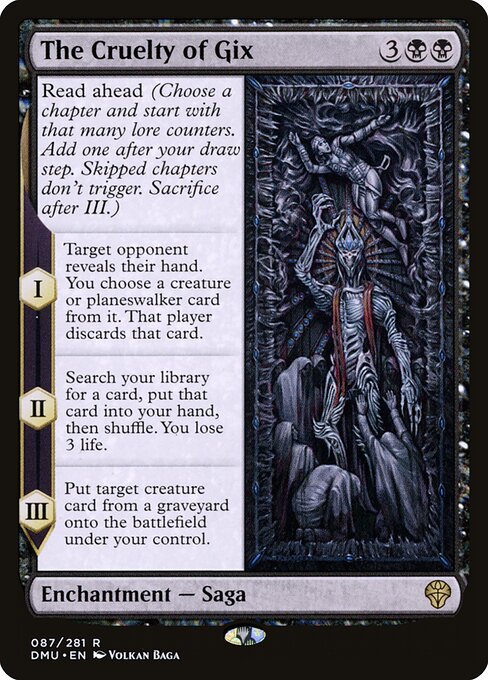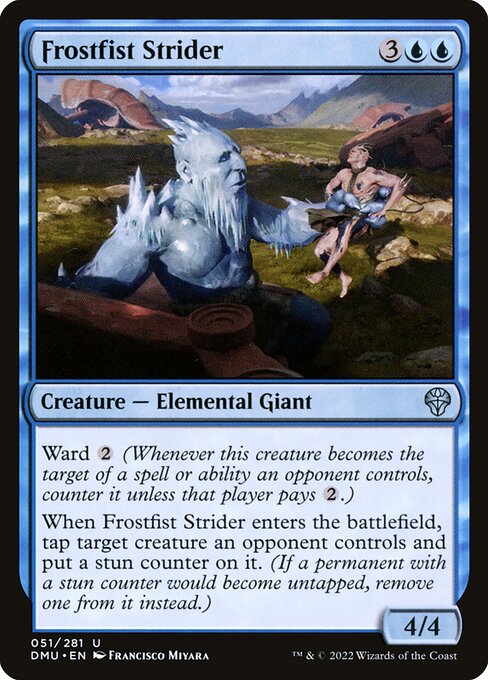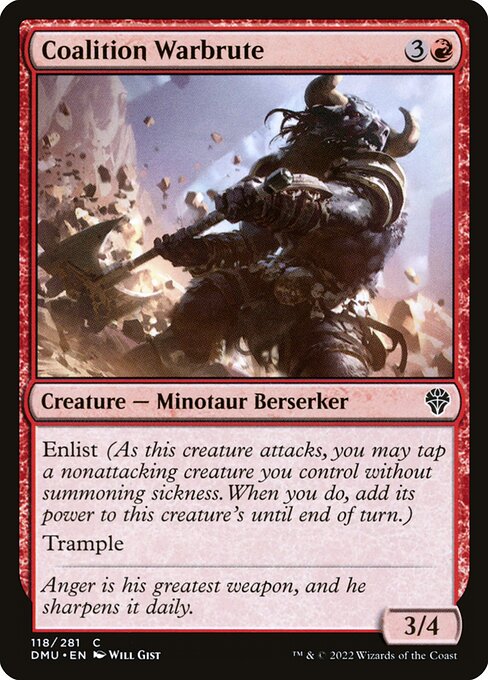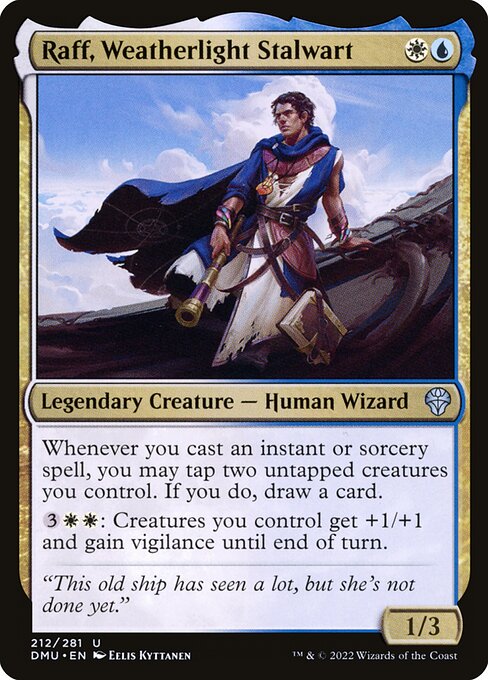Welcome back to another Mechanics in Review, where we, you guessed it, review the mechanics of Magic sets. The title rightly makes it a bit obvious. It’s been several months since Dominaria United and The Brothers’ War (which we’ll get to next time) released, which is enough time to have perspective but not so much time that the set requires accessing hazier, long-term memories. So, how did its mechanics stack up?

Returning Friends
These reviews are focused on new mechanics rather than returning mechanics. That said, we always carve out a bit of time to quickly touch upon innovations in the familiar. It’s especially important to do so with Dominaria United, as it followed the lead of Kamigawa: Neon Dynasty and put most of the spotlight on familiar faces. This means there was less pressure on newer mechanics to be at high volume or build excitement (which I’ll argue bore out in their execution).
Dominaria United Limited was built around two returning mechanics, Kicker and Domain, though it also gently featured a third familiar mechanic in Poison (on Ajani, Sleeper Agent,). None of these mechanics introduced anything especially novel, yet the context of Dominaria United did recontextualize them in fun new ways. Kicker only showed up as an off-color bonus and with repeated effects (blue Kicker costs often drew cards, white ones made tokens, and so on), but we’ve seen those tools used way back when Kicker premiered in Invasion block. Domain did what it’s always done and provided rewards for diversifying your deck’s manabase.
Dominaria United’s novelty came from the interaction of off-color Kicker and Domain (which both reward you for at least touching as many colors as possible) with the second-ever set of common dual lands with basic land types. This meant that almost all decks benefitted from playing lots of colors while allowing a spectrum of possibility: some gently splashed just to increase their Domain or occasionally power up a Tolarian Geyser, while others ran reliable 3 color manabases, and many could be traditional 4-5 color goodstuff decks. We basically never see formats enabling 2-5 color decks (about) equally, so this balance made Dominaria United a unique format composed of familiar components. Accordingly, I’d argue Kicker and Domain are impressively innovative and successful by virtue of their context and balance rather than by carving out new mechanical space.
We’ll save talking about Powerstone tokens until our upcoming Mechanics in Review: Brothers’ War. Yes, they premiered here on Karn, Living Legacy, but the mechanic wasn’t fleshed out until the following set. Instead, we’ll move right on to the new mechanics.

Skip to the Good Part
Sagas premiered in 2018’s Dominaria and almost instantly became deciduous. They’ve been featured heavily in Theros Beyond Death, Kaldheim, and Kamigawa: Neon Dynasty. We even ranked them as the #2 best mechanic of the past decade. In short, Sagas are fantastic design creation. They returned in Dominaria United with their first big mechanical twist in Read Ahead.
Sadly, I didn’t love it.
Read Ahead didn’t seem to introduce massive or especially exciting design space. The ability to Read Ahead allows for highly context-sensitive first chapters, since you can always skip them. However, Read Ahead also mitigates the power level of final chapters. With traditional Sagas, the last (or even the second) chapter could be a disproportionately powerful effect that justified its low cost by effectively having Suspend. Read Ahead Sagas can’t do that. The end result seems to be highly constrained, as they need to function as Sorceries with a single effect, full-lenth Sagas with multiple effects, and partial-length Sagas. I found them mostly forgettable. This is partially due to them being far lower in volume and power level than Kamigawa: Neon Dynasty (with six Sagas at common to DMU’s zero), but I found the tension they added of choosing the starting chapter didn’t add very much enjoyment. I like how straightforward and evocative prior Sagas, and Reading Ahead skipped past some of their elegance.

A Big Exertion for a Few Cards
Stun counters are a new type of evergreen counter, joining the ability counters from Ikoria: Lair of Behemoths almost three years ago. They provide a physical reminder for effects like Frost Breath and Kor Hookmaster. They open up new design space by allowing cards to be locked down for more than one turn, although Impede Momentum and Involuntary Cooldown are the only two to do so (well, since 1993’s Telekinesis). The introduction of Stunning demonstrates that Wizards is now comfortable with having multiple types of counter in a set that commonly go on creatures (previously, the limit was one type of counter at common) as well as more comfortable putting punch-out counters in booster packs.
I was and remain fairly surprised that stun counters exist. Perhaps Frost Breath effects had bigger memory issues than I remember, but the effect basically only lasts until the end of the turn (your opponent’s first action on their turn is not untapping that creature, then the effect ends). This could be a multiplayer consideration, but none of the four cards that Stun seem intended for Commander. The main reason to use counters is for effects that last longer than a turn—this gives blue a new twist on tempo removal, but it’s hard to imagine more than a couple Stunning cards per set (so far, we’ve had 2 in DMU, 1 in BRO, and 0 in ONE).
Perhaps Stun counters have a low-enough cognitive cost that they’re fine. After all, every card that Stuns has explanatory text, and Stun counters are distinct from and placed differently than +1/+1 counters, so they won’t be confused for each other. Perhaps enough people were forgetting to skip untapping after a Berg Strider or Rooftop Nuisance. That physical reminder really is justified. Still, I’m not convinced of their necessity or that they open up much design space by allowing creatures to be Stunned for additional turns. Will this mechanic ever be used at sufficient volume to justify its keywording? How many cards are we going to see that Stun for more than one turn? Will it go the way of Prowess, where it quickly fades into disuse? It didn’t fit in Phyrexia: All Will Be One due to its interaction with Proliferate, and there likely will be more such conflicts in the next year or two.

Fixed Banding with Less (But Still Lots of) Text
Banding is one of Magic’s first keywords (right up there with Flying, Trample, and Swampwalk). It communicates a simple, resonant, and evocative concept—creatures teaming up—but does so in an overly complicated way that punishes aggression and grinds games to a halt. Enlist fixes that. It’s a fairly complicated keyword that only functions on offense, so it helps bring games to a conclusion.
Enlist is a risk/reward mechanic, where you make an informed choice about how best to allocate your creatures. It turns itself off unlike more repetitive (and powerful) mechanics like Exalted, so you can’t keep upgrading your creatures turn after turn—you have to risk your Enlist creatures in combat. Those are solid traits for the mechanic, though I’ve found it had fairly limited utility. When you were ahead on board, it generally did nothing—attacking with all of your creatures likely increased the amount of damage you got in, and Enlisting never increases your amount of attacking power. When behind, Enlist does nothing, since you’re probably not attacking. Enlist only does good work in the narrow band of parity or slightly-ahead boardstates—there, it lets you effectively attack with your biggest creature without actually risking it in combat.
Enlist isn’t a simple mechanic. It requires 4-5 lines of explanatory text. It fights some player intuition by not working with Vigilance or summoning sick creatures. It seemed to work on a limited range of creatures (Enlist creatures had square or defensive stats, as adding extra power to a low toughness creature usually accomplishes little). And it often didn’t play super well (outside of on Guardian of New Benalia, which it arguably worked too well). Add all that together and you’ve got a mechanic with several issues and limited utility. It struck me as a perfunctory combat mechanic because the set needed a new one.

While I really enjoyed drafting Dominaria United, none of its mechanics ranked high in my book. That’s not terribly surprising, as it’s exactly what happened with Neon Dynasty. Kamigawa’s new mechanics were workhorses that helped the set function while giving the spotlight to reprinted mechanics like Ninjutsu, Sagas, and Channel. DMU’s focus was Domain and Kicker, not Enlist, Stun counters, and Read Ahead. That speaks well to the set’s construction, and also suggests what Magic’s future may look like. We’re seeing more popular mechanics return faster and more frequently than ever in Premier expansions, more mechanics be promoted to deciduous or evergreen (like Cycling in SNC and Flashback in ONE), and more mechanical callbacks in non-Premier sets like Commander products and Horizons sets. At the same time, some Premier sets are exclusively using their new mechanics as structural support rather than as central features of Limited or Constructed. That’s hardly a universal paradigm, as SNC and BRO were very much focused on their new mechanics. It’s still a major change from how Magic built mechanics over the past thirty years. We may well be in an era where well-established and popular mechanics are increasingly the foundations upon which sets are built around, while newer mechanics more often serve as glue.
And with that, that brings our evaluation of DMU’s mechanics to a close. Here’s hoping you enjoyed that, that you have a blast at any ONE prerelease events you’re heading to this weekend, and that you’ll return next time when we tackle BRO’s mechanics.
Zachary Barash (he/him) is a New York City-based game designer and the last commissioner of Team Draft League. He designs for Kingdom Death: Monster, has a Game Design MFA from the NYU Game Center, and does freelance game design. When the stars align, he streams Magic (but the stars align way less often than he’d like).

